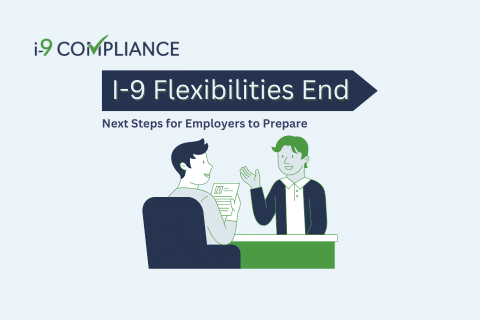Next Steps for Employers to Prepare for the End of I-9 Flexibilities

May 18, 2023
Significant changes are coming soon for employers that have availed themselves of the Department of Homeland Security’s (DHS) flexibilities for employment eligibility verification (Form I-9). For example, the DHS announced a firm deadline for completing the in-person verification of these forms.
Previously, the DHS announced that these flexibilities would end on July 31st, 2023. Before that, the DHS repeatedly extended the policy, allowing employers to continue the precautions they adopted due to the pandemic. However, the Department has clarified that employers will have only 30 days after the closure of flexibilities to review remotely verified forms in person.
Following the federal emergency’s end is the announcement of a grace period. As a result, employers will find this is the end of remote flexibilities. The question is: What should employers do to prepare for the return to in-person verifications? Here are a few steps.
- Identify all virtually reviewed Form I-9s. Employers must contact affected employees to schedule an appointment to inspect their documentation in person. The employer or an authorized representative may review the information in this step.
- Determine who will perform the inspection. If the original representative is available, then they can perform the inspection and add their initials alongside “COVID-19; Documents physically examined on (date)” to the additional information field of Section 2 or 3 as appropriate. When the original inspector cannot participate, the employer may have a new representative take their place. The new representative should complete and attach a new Section 2 or 3 to the existing Form I-9 with a brief explanation in the additional information field.
- Some documentation submitted for the remotely verified Form I-9 may have expired by the time the in-person review occurs. Employees may reuse the documentation for the in-person examination if it is valid in the virtual inspection.
- Should the original documentation prove unavailable for inspection, the employer should complete a new Section 1 in the form. They must also provide a qualifying document from List A or a combination of Lists B and C documents. The representative for the employer should use the date of hire on the new Form I-9 on the original, then attach the new Form I-9 to the original. The representative for the employer should then state in the “Additional Information” field why they needed the new Form I-9.
As this change shows, federal and state regulations regarding the employment eligibility verification process constantly shift. Therefore, employers must keep up and ensure compliance to avoid unnecessary liability. The best way to do this is with an electronic Form I-9 management tool. This tool can guide employers throughout the process and provide convenient storage and reminders when to take action to ensure continued compliance.
Learn more about automating your employment eligibility verification and ensuring compliance with I-9Compliance.